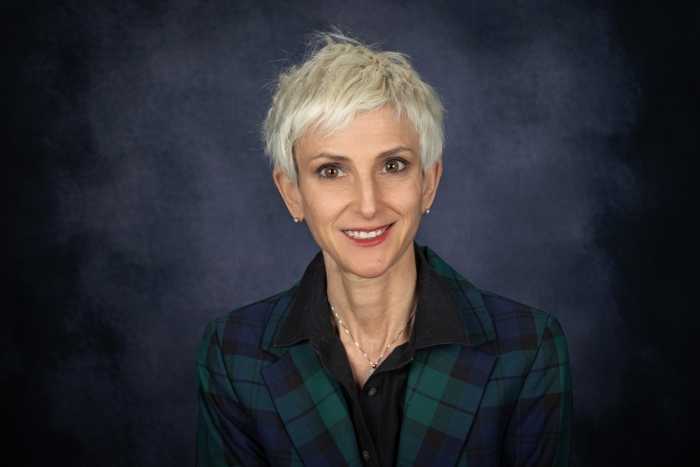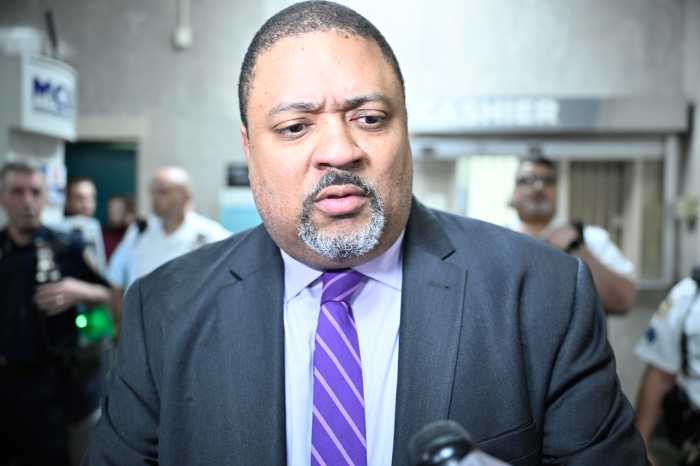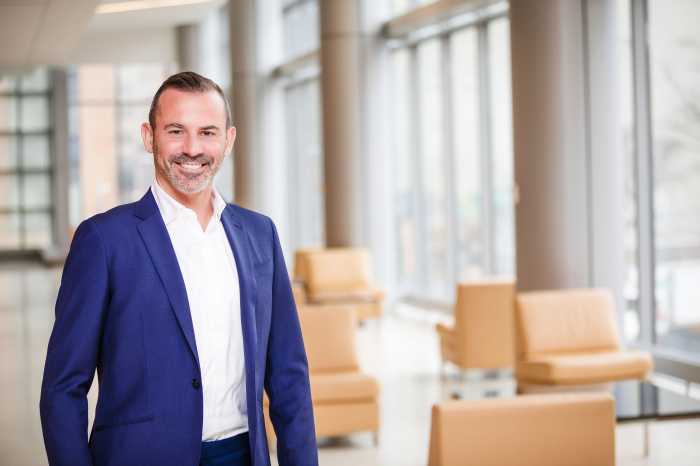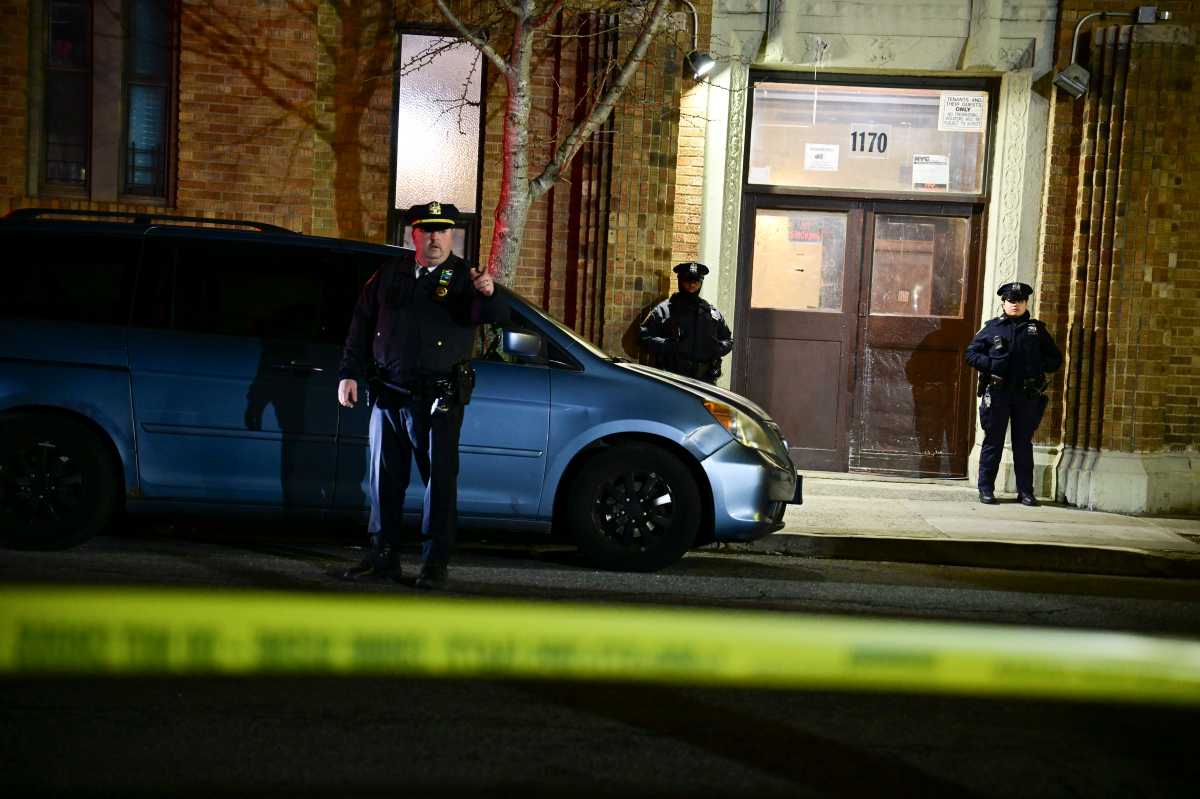As the presiding judge of Brooklyn’s Mental Health Court, Matthew D’Emic’s office is like a museum, filled with the art work of defendants who have come before him
He has a portrait of a St. Nicholas in the Ukrainian Orthodox Church-style that a defendant painted. Another gave him a painting of lilies that sits by his window. Others have sent cards and letters after graduating from the diversion court.
But D’Emic also finds comfort in the people he never hears from again. It generally means the person he’s released is safe, has not caused harm and is not in jail.
“I always say that you can’t do this job afraid, but you have to be very careful,” said D’Emic, who has presided over the mental health court for more than 20 years. “If I was afraid [I] would want to put everybody in jail, right?”
The diversion program D’Emic oversees works by steering adults with mental illness who have committed misdemeanor and felony offenses away from the justice system and into treatment.
D’Emic’s insight as the head of the court has taken on statewide importance as New York State Chief Judge Rowan Wilson advocated to make every court a problem-solving court. As part of that mission, Rowan designated D’Emic as a co-chair of the task force in charge of expanding the state court system’s mental health services.
D’Emic, in his gentle Brooklyn cadence, said that none of this was planned. The fact that his work has become world renowned (he’s given talks on the court in Scotland and hosted judges from Australia and Canada) seems to come to him as a pleasant surprise.
“I’m the luckiest state court judge alive,” said D’Emic who also serves as administrative judge of the criminal court in Kings County Supreme Court.
In fact the reputation is secondary to what grounds his practice: his connection to its participants.
D’Emic recalled a young man in his early twenties during the pandemic who wound up in his court after he got into an argument with a stranger, stabbed them and screamed some “islamophobic remarks” — an event that was charged as assault in the second degree, a hate crime that would come with some serious jail time.
He was diagnosed with mental illness, and entered the program while living with his family. Though he was shy in court, D’Emic said that he stayed in the program for a year and showed signs of improvement. D’Emic considers it a success that he hasn’t heard from the man or his family since.
“That’s an example of a kid that would be in prison and get out after a couple years and to what good?” D’Emic asked.
His perch has come with tremendous responsibility for those who go through his court. He’s heartened by its many successes but also haunted by the ones that didn’t work out, like the several cases where participants died by suicide while going through treatment.
Mental health court origins
Former Chief Judge Judith Kaye and Brooklyn District Attorney Charles J. Hynes created Brooklyn’s Mental Health Court in 2002, initially to handle non-violent felonies. As the Center for Justice Innovation planned the court, D’Emic, who was working on a domestic violence court, was asked if he wanted to head it up.
D’Emic said at the start it was a humbling experience, which tested him as a judge, but he took the opportunity because it spoke to his values.
“Here you’d have the opportunity to keep people out of prison. It appealed to my own sensibilities about justice, like the belief that justice always has to look further than its reach, so to speak,” he said. “It was an opportunity to help.”
It started off slowly. Most models for mental health courts across the country at the time were for misdemeanors — with even fewer courts that took on violent offenses.
But one of the first cases referred to the court was a young woman who killed her infant at the moment of birth, which served as a test case for taking on certain instances of violent felonies.
“It wasn’t a case that really we could handle but the clinical director at the time and I decided if we wanted to do the good we hoped to do, we’d have to take violent felonies,” D’Emic recalled, adding that the stakes were high as the state’s first-ever mental health court. “If we take a violent felony and something goes wrong, that’s the end of mental health courts in New York state.”
Now about half of the court’s cases involve people who have pled guilty to a violent felony, D’Emic said. “I think over the past 20-some odd years we’ve proven that you could effectively release people into the community,” he said.
Cases like the young woman who killed her infant and the young man charged with a hate crime charge affirmed his belief that supervised treatment is a viable alternative to incarceration. To determine eligibility, psychiatrists give a dangerousness assessment that considers aggravating factors like a history of violence or drug abuse, which can often increase the risk of violence. He also considers how much family support the accused person has and if they have a place to live.
“Family support, community support, motivation is a very important factor, I think,” D’Emic said. “Do they have any insight into their mental illness? If they’re denying the fact that they’re mentally ill, they won’t take medication. Well, that’s a huge problem.”
Gaps in the system
There is a huge misconception that people with mental illness are inherently dangerous, D’Emic said, when people with serious mental illness are more likely to be victims. That is where the government’s role comes in.
The gaps in care often stem from a lack of available beds for those with mental illness who are a danger to themselves or others. As a result, that population is sometimes released from inpatient care too soon, D’Emic said. This leads to them being sent “back to the subway grate or the cardboard box, where they’ll be right back where they started from.”
“I think that’s the gap,” he said, adding that in a perfect system the seriously mentally ill would have greater access to treatment and avoid criminal behavior entirely. “Because once they’re in [criminal] court, we do what we can. I think we do good work, but we’ve lost already, right?” D’Emic said.
Ultimately it’s not D’Emic’s call as a criminal judge whether to hold people in inpatient services. When the MTA or NYPD officers take someone with mental illness in custody after deciding that they cannot take care of themselves, the case goes to a hearing before a civil court to determine whether or not the commitment should be extended.
But the responsibility for the cases of criminal defendants who might otherwise be held in jail also comes with emotional stakes.
“We see these people every week. I bring them up to the bench. I’m close to them, but not just me, the court officers, the court clerks,” D’Emic said. “You have to be extremely careful. You don’t wanna be responsible for innocent victims.”
D’Emic’s career path didn’t start as a mission to serve those with mental illness, or even work in criminal law. For 15 years, he worked as a general practice attorney at a firm and operated his own practice. Looking for a change of pace in 1995, he ran and lost an election for civil court, but the governor ended up appointing him to the court of claims, from which he was assigned to the supreme court.
“I came in in 1996 as a regular criminal term supreme court judge trying to be an efficient docket manager, basically,” he said.
From there, he was given a domestic violence court assignment, which came with more responsibility, leading him to play a part in the pioneering mental health court.
Future of mental health policy
As the co-chair of the newly-formed New York State Judicial Task Force on Mental Illness D’Emic’s focus is on extending specialized mental health courts across the state.
After issuing set of recommendations in June including the creation of a two-year pilot program for assisted out-patient treatment (AOT), creating mental health courts in family court and building out regional mental health courts in low-volume counties, D’Emic said that he’s seen a remarkable amount of progress in the intervening two months.
The concept of regional mental health courts has hit some jurisdictional obstacles but may end up getting rolled into state legislation like the “Treatment Not Jails” act.
With Wilson’s involvement as a major boost for the taskforce’s morale, D’Emic said he saw an outpouring of interest in studying mental health courts within the family court system. And he confirmed that the AOT proposal, which could mandate outpatient behavioral health treatment under the oversight of a judge, is going to be implemented in three counties—Nassau, Kings and Onondaga — to study its effectiveness in urban, suburban and rural areas.
D’Emic argued that this program, which he admitted is contentious among judges because it can saddle defendants with more court appearances, is effective specifically because it can kindle a rapport between the judge and the defendant.
“My own thinking is we’re gonna find that it’s very helpful because I’ve been doing the mental health court for 22 years,” he said,“and I find that my ability to establish a relationship with the criminal defendant in front of me — it helps in success.”





































